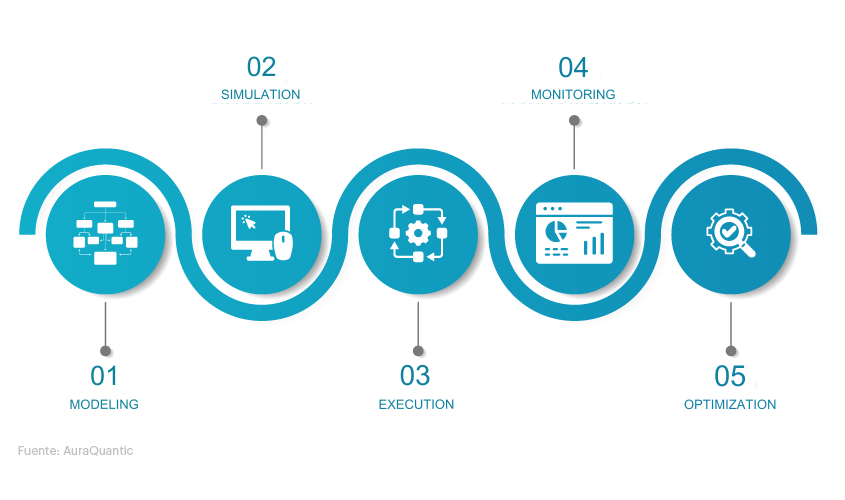
The BPM lifecycle or BPM management process is a method of implementing and managing business processes that has undergone certain adjustments, as technology and the way companies are managed have evolved.
On the other hand, although there is a significant number of publications hosted on the Internet that offer information about the different phases that make up the life cycle of the processes, surely if you have come this far you will have realized that many of them offer disparate versions. By this, we mean that, in some cases, it has been decided to eliminate or add stages, while modifying the sequential order of execution.
Under this premise, this guide aims to serve as a consultation tool, both for professionals in the technology sector and for less technical profiles, interested in resolving any doubts or issues that may arise around the concept or phases of the BPM life cycle.
What is the BP life cycle?
The reasons that can lead a company to launch a BPM initiative are diverse, including increasing operational efficiency, reducing costs, improving quality, and regulatory compliance. Likewise, and considering the achievement of long-term goals, business process management is an essential practice to ensure business success.
This is because it enables organizations to respond quickly to changing market conditions, adapt their business model, and bring their strategy to operational execution through processes, people, and technology“, as the authors point out. August-Wilhelm Scheer and Eric Brabander in the chapter ” The Process of Business Process Management“, contained in the work Handbook on Business Process Management 2.
Thus, Business Process Management — in English, Business Process Management, BPM— has established itself as an efficient and effective alternative to functional management, by advocating a process-focused vision, to promote direct improvement in the way work is performed.
Now, to map the processes — the practice of visualizing and documenting in detail the steps, activities, and workflows involved in a specific process within an organization— and guarantee a commitment to continuous improvement, different phases of integrated BPM have been conceptualized within what is called the BPM life cycle.
A concept that highlights the role that technology plays, in symbiosis with the human resources involved in the management and execution of business processes.
That said, we can define the BPM life cycle or process management framework as a model that systematizes the steps and activities that must be followed to implement and manage processes effectively.
A structured approach is composed of stages that are executed sequentially, to implement and manage processes business.
Review of modelos theorists of BPM life cycle
To date, different theoretical models of the BPM life cycle have been documented in the literature, which takes as reference the traditional conceptual framework on which business process management is based. These have been prepared by renowned consulting companies, software providers, and the community of academic researchers, as explained by Marek Szelągowski, from the Systems Research Institute of the Polish Academy of Sciences, in a publication made on the occasion of the annual celebration of the Conference on Computer Science and Intelligence Systems (FedCSIS), in 2018.
In this way, we find proposals as disparate from each other as those detailed in the following table, where we mention the source consulted, the authors, and the stages that make up each of the models.
The existence of multiple models evidences the need to have an updated theoretical framework that unifies all phases or stages which includes the BPM life cycle, under a single perspective. Therefore, below, we present the one that has been used in AuraQuantic for more than 20 years, as an instrument and iterative approach to process management and optimization.
Model cauraquantic BPM Life Iclo
AuraQuantic proposes a life cycle to manage processes that consist of five phases: Modeling, Simulation, Execution, Monitoring, and Optimization. Next, we will review them to understand what they consist of and what activities each of them encompasses.

Phase 1) Modeling
Modeling is the first stage of the BPM life cycle. This is divided, in turn, into two subphases:
- Diagramming: It consists of designing a diagram with the operation of the process that you want to develop. To do this, Business Process Modeling Notation —in English will be used Business Process Modeling Notation, BPMN—, a graphical standard widely used for process modeling, that is, to visually represent the elements and steps of a business process.
- Parameterization: Once the process has been diagrammed, it will be configured. This involves defining or adjusting the values or attributes that correspond to each of the objects represented in the diagram, giving answers to questions such as: Who executes each option? What data do you receive? What data does it provide? Should the process be integrated with more applications? How much time is available? What conditions must be met to redirect the flow in one direction or another? What does the system report and who does it notify (automatically)…?
Phase 2) Simulation
At this stage, an evaluation of the operation of the modeled process is carried out, before implementing it in the real environment, to check how it works. This simulation can be carried out in two ways:
- Statistical simulation: This typology allows the creation of hypothetical scenarios, through the introduction of probabilistic data into the system. In this way, the results of an indeterminate number of processes can be known and quantified.
- Real simulation: This type of simulation is used to know or verify the real results of the processes during their execution. The degree of reliability of this type of simulation is greater than the previous one since it offers a detailed and precise representation of what will happen to the processes in reality.
Phase 3) Execution
Once the results obtained after the simulation have been evaluated, either probabilistically or actually, and the absence of errors has been confirmed, the next stage in the BPM life cycle is execution. Using a Business Process Management Suite —in English, Business Process Management Suite, BPMS— that integrates technology among its functionalities No Code, is key in the management of all stages of the BPM life cycle, although it becomes especially relevant during the implementation or start-up of the process.
The fundamental reason is that this technology eliminates the need to write programming code; The process simply must be published to activate it, just like with a website. After being published, and depending on the nature of the process, it will be available to different types of users. By this, we mean that a process created to manage work vacation requests will only be accessible to the internal public of an organization, while another related to the contracting of a product or service will be available to clients or external audiences.
Phase 4) Monitoring
Once the process is running, data is generated that allows its performance to be continuously monitored and evaluated, to ensure that strategic objectives are being met and operational efficiency is improved.
In this phase, key performance indicators (KPIs) are identified and established to measure the performance of the processes; alerts and notifications that report deviations or critical events —situations or conditions considered of great importance or severity within the system—; trends and patterns are analyzed; and, also, periodic reports are generated to promote transparency and alignment with defined objectives.
The lack of monitoring and optimization of a process leads to its deterioration. Therefore, its adaptation is necessary and continuous improvement takes into account the changes that occur in customer needs, competition, and technology.
Furthermore, it is essential to consider the phases in the BPM life cycle cyclically, given that the results obtained during monitoring feedback to the rest of the stages.
Phase 5) Optimization
Continuous improvement is a fundamental principle in business process management. At this point in the cycle, modifications will be carried out taking into consideration the aspects susceptible to improvement, detected in the previous stage. Depending on the type of software used, changes will be made more or less quickly and easily.
Final reflections
In short, all organizations have processes. Now, understanding and managing these processes appropriately to ensure that they consistently produce value is essential for the effectiveness and competitiveness of organizations.



